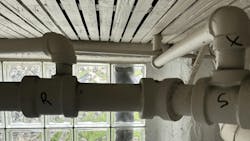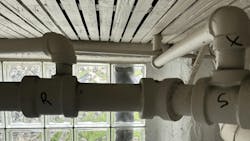Last month I wrote about early steam heating and how experimentation led to discovery, which led to new products or piping techniques. This time I will be writing about the early days of gravity hot water heating systems, when people were testing new ideas to be more competitive with steam heating systems.
I am writing again from the chemotherapy chair, in the big room with twenty other people getting some kind of treatment, usually through an IV drip. In my world of hydronics, it is gravity feed. The bag is higher than the point of entry into the body, so the fluid treatment flows right in at the rate determined by the medical staff.
After four hours, I’m discharged with a chemotherapy pump, which works on the principal of the pump producing a positive pressure to get the treatment into my body without having to hang a bag over my head for two days and nights. Anyway, I’m always distracted by tubes and pumps.
Hot Water vs. Steam
Before 1928, hot water heating systems did not have a pump, because it wasn’t invented yet. In the years before, pipe fitters/designers usually ran a separate supply and return pipe in the basement to circulate hot water from the boiler to the radiators, with tees in the main to branch off to the individual radiators upstairs.
If the pipes were large enough, water flowed with ease. But that was the problem: those two big supply and return pipes came with a high price. A hot water system would be more expensive than steam.
This was at a time when there was competition between hot water systems and steam systems. The radiators are bigger and more expensive than steam. The piping of a two pipe steam system would be less expensive because it has a large supply pipe, but much smaller return pipe. One pipe steam would be the cheapest, but the homebuyers back then didn’t like the hissing air vent at every radiator. Can’t blame them for that—nobody should.
What if you could use one single supply/return main distributing steam in the basement to the branch circuits? Well it turns out that it was possible. The photos are from a house in a prominent neighborhood built around the turn of the century. The era when steam and hot water contractors competed for the opportunity to cut and fit large pipes, assemble radiators on site, and install a giant coal fired cast iron sectional boiler.
One Pipe Hot Water System
A contractor contacted me about this job to see if he was on the right track of understanding what he was looking at. I had him send a few pictures to make sure I understood what he was looking at. They confirmed what he was describing, a vintage one pipe gravity hot water system.
I rarely run across these one pipe hot water systems. The first time it took me awhile to figure out how it worked. The trick is getting hot water to flow out of the branch of a tee on the supply/return main to the radiator, to displace the cooler water in the radiator, forcing it down and back into the main.
Today we use a pump and a special tee in the supply/return main that diverts a certain amount of flow out of the branch. The pump is sized to overcome the resistance to flow through the now smaller main, branch lines, radiator and boiler.
Back then, since the pump hadn’t come along yet, they sized the pipe so there was virtually no resistance to gravity flow. The hot water in the boiler moved up because it was lighter than the water in the system while the cooler water fell because it was heavier. All the water moved at the same time, again, if the pipes were large enough.
Orientation Determines Flow
What I figured out was the different orientations of the branch circuit off the main determined the flow. If the branch is pointing up, the hot water naturally moves up. So that was always the tee that was closest to the boiler, while the return from the radiator would be the next downstream. In the first photo, flow is from right to left. In that photo, it looks like both tees have the branch pointed up, but the second photo shows the return tee laying on its side.
The orientation of the return tee is to the side of the pipe to discourage flow up to that branch. This side orientation of the return tee is something you normally see on the two pipe gravity flow hot water systems.
The contractor that installed this job thought, why have an expensive return line when you can have the return piping combine with the supply piping? Same amount of tees, just a lot less large pipe. It must have worked at this house since the piping hasn’t changed for over a hundred years.
One Pipe Problems
The problem I see with one pipe hot water systems, vintage or modern, is the water temperature drop in the supply/return main. Let’s say water leaves the boiler at 180°F. In a two pipe hot water system, gravity or pumped, the water temperature to each branch tee is pretty consistently the same. There isn’t enough difference to consider when selecting radiation.
However, in a one pipe system, gravity or pumped, the water temperature is not the same at each branch, because the cooler water from the radiation is mixing with the warmer water. The result is progressively cooler water to the end of the supply/return main.
If the main is long enough and with enough radiation, then the supply water temperature could drop as much as 30°F. This is okay if the guy selecting radiation knows this is happening. He can then use decreasing supply water temperatures for selecting radiation.
I want to give a shoot out to the contractor that I suspect may have installed this job. He’s a hometown guy that invented a fitting especially for gravity hot water risers, not the main. He is Oliver Schlemmer and he named it for himself, the O.S. fitting. I figure here’s a guy who was trying ways to improve the cause of one pipe gravity hot water systems, he was a plumber that installed systems in that era, and he was local.
Patrick Linhardt is a forty-one-year veteran of the wholesale side of the hydronic industry who has been designing and troubleshooting steam and hot water heating systems, pumps and controls on an almost daily basis. An educator and author, he is currently Hydronic Manager at the Corken Steel Products Co.
About the Author
Patrick Linhardt
Patrick Linhardt is a forty-one-year veteran of the wholesale side of the hydronic industry who has been designing and troubleshooting steam and hot water heating systems, pumps and controls on an almost daily basis. An educator and author, he is currently Hydronic Manager at the Corken Steel Products Co.


